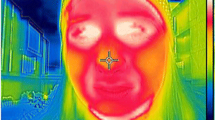Abstract
Many patients with angina note that their symptoms deteriorate in cold weather, although the precise physiological mechanism that explains this remains unclear. Exposure of the face to cool winds may be a contributory factor. The cardiovascular and hormonal response to a localised stream of room (22°C) and cold (4°C) air during submaximal treadmill exercise was therefore studied in nine normal subjects. Cardiac output and respiratory gases were measured with a mass spectrometer, using the indirect Fick principle. Blood samples were taken for plasma noradrenaline. A localised stream of air at 5 m · s−1 produced significant cardiovascular effects at rest, some of which persisted during exercise. In response to cold air, stroke volume, cardiac output, blood pressure and oxygen uptake increased (allP < 0.05). There was a trend towards a reduction in heart rate at rest and increase in plasma noradrenaline. Room air caused a reduction in blood pressure (P = 0.01) but stroke volumes and oxygen uptake were unchanged. The results of this study demonstrate significant cardiovascular effects of a cooled air facial stimulus at rest and during exercise. They may, in part, explain the effects of cold winds on patients with angina.
Similar content being viewed by others
References
Abboud FM, Eckstein JW (1966) Reflex vasoconstrictor and vasodilator resonse in man. Circ Res 18, 19 [Suppl I]: 96–103
Alexander G, Bell AW, Hales JRS (1973) Effects of cold exposure on tissue blood flow in the new born lamb. J Physiol (Lond) 234:65–77
Andersen HT (1963) The reflex nature of the physiological adjustments to diving and their afferent pathway. Acta Physiol Scand 58:263–273
Anton AH, Sayre DF (1962) A study of the factors affecting the aluminium oxidetrihydroxyindole procedure for the analysis of catecholamines. J Pharmacol Exp Ther 138:360–375
Bravo E (1986) Plasma catecholamines: their measurement and clinical utility. Lab med 30:512–516
Burton AC, Edholm O (1955) Man in a cold environment. Arnold, London
Cowley AJ, Stainer K, Murphy DT, Murphy JJ, Hampton JR (1986) A non-invasive method for measuring cardiac output: the effect of Christmas lunch. Lancet 11:1422–1444
Epstein SP, Stampfer M, Beiser D, et al (1969) Effects of a reduction in environmental temperature on the circulatory response to exercise in man. N Engl J Med 280:7–11
Graham TE, Sathasivam P, MacNaughton KW (1991) Influence of cold, exercise and caffeine on catecholamines and metabolism in men. J Appl Physiol 70:2052–8
Hanna JP, McN Hill P, Sinclair JD (1975) Human cardiorespiratory responses to acute cold exposure. Clin Exp Pharmacol Physiol 2:229–238
Hayward JM, Holmes WF, Gooden BA (1976) Cardiovascular responses in man to a stream of cold air. Cardiovasc Res 10:691–696
Hiramatsu K, Yamada T, Katakura M (1984) Acute effects of cold on blood pressure, renin-angiotensin-aldosterone system, catecholamines and adrenal steroids in man. Clin Exp Pharmacol Physiol 11:171–179
Hjemdahl P (1993) Plasma catecholamines—analytical challenges and physiological limitations. Ballieres Clin Endocrinol Metab 7:307–353
Kontos HA, Wasserman AJ (1969) Effect of reserpine in Raynauds phenomenon. Circulation 39:259–266
Lassvik CT, Areskog NH (1979) Angina in a cold environment. Reactions to exercise. Br Heart J 42:396–401
Lassvik C, Areskog NH (1980) Angina pectoris during inhalation of cold air. Reactions to exercise. Br Heart J 43:661–7
LeBlanc J, Blais B, Barabe B, et al (1976) Effects of temperature and wind on facial temperature, heart rate and sensation. J Appl Physiol 40:127–131
Nabel EG, Ganz P, Gordon JB, et al (1988) Dilation of normal and constriction of atherosclerotic coronary arteries caused by the cold pressor test. Circulation 77:43–52
O'Hanlon JR, Horvath SM (1970) Changing physiological relationships in man under acute cold stress. Can J Physiol Pharmacol 48:1–10
Quirion A, Laurencelle L, Paulin L, et al (1989) Metabolic and hormonal responses during exercise at 20 degrees, 0 degrees and − 20 degrees C. Int J Biometeorol 33:227–232
Reybrouck T, Fagard R (1990) Assessment of cardiac output at rest and during exercise by a carbon dioxide rebreathing method. Eur Heart J II [Suppl 1]:21–25
Russell AE, Smith SA, West MJ, et al (1990) Automated non invasive measurement of cardiac output by the carbon dioxide rebreathing method: comparison with dye dilution and thermodilution. Br Heart J 63:195–199
Author information
Authors and Affiliations
Rights and permissions
About this article
Cite this article
Walsh, J.T., Andrews, R., Satin, P.D. et al. Haemodynamic and hormonal response to a stream of cooled air. Eur J Appl Physiol 72, 76–80 (1995). https://doi.org/10.1007/BF00964118
Accepted:
Issue Date:
DOI: https://doi.org/10.1007/BF00964118




